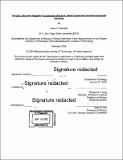Insights into gene regulation by genome structure, phase separation and developmental signaling
Author(s)
Zamudio, Alicia V.(Alicia Viridiana Zamudio Monters de Oca)
Download1199073234-MIT.pdf (22.27Mb)
Other Contributors
Massachusetts Institute of Technology. Department of Biology.
Advisor
Richard A. Young.
Terms of use
Metadata
Show full item recordAbstract
Proper regulation of gene expression is essential to the developmental processes that give rise to hundreds of different cell types with unique cellular identities. Regulation of protein-coding and long non-coding RNA genes by RNA polymerase II is carried out by the coordinated action of transcription factors and cofactors. Transcription factors can be cell-type specific and bind cell-type specific gene regulatory regions called enhancers, which can be located far upstream or downstream from the gene they activate. The enhancer-bound factors can loop to the promoters of cell-type specific genes to enhance the levels of transcription of these genes, and studies described in this thesis have provided new insights into the factors that contribute to this looping process (Weintraub et al., 2017). Recent studies have revealed that super-enhancers, which contribute to regulation of genes with prominent roles in cell identity, form phase-separated condensates that compartmentalize and concentrate the transcription apparatus at these genes. This insight led us to test the idea that signaling factors, which bring information regarding the developmental environment of cells to the transcription apparatus, might preferentially interact with super-enhancers through condensate interactions that were not considered in previous studies of signaling. Our studies confirmed that super-enhancer condensate do indeed facilitate the preferential localization of signaling factors to genes with prominent roles in cell identity (Zamudio et al., 2019). Thus, the studies described in this thesis provide new insights into gene regulation by genome structuring, phase separation and developmental signaling.
Description
Thesis: Ph. D., Massachusetts Institute of Technology, Department of Biology, 2020 Cataloged from PDF of thesis. Includes bibliographical references.
Date issued
2020Department
Massachusetts Institute of Technology. Department of BiologyPublisher
Massachusetts Institute of Technology
Keywords
Biology.